|
|
Eaton's Winnipeg and Toronto Catalogues Compared
by Catherine C.
Cole
In 1905, John C. Eaton convinced his father Timothy
that there
was a growing market in Winnipeg and Western Canada that should be met by
a regional
catalogue. Eaton's faced competition from a number of western
department
stores and local stores, but captured a huge share of the market. Until
the Second
World War, the Toronto and Winnipeg catalogues were different in
structure, goods
offered, and descriptions, as Eaton's successfully targeted the
western
market.
Eaton's in Winnipeg |
Marketing to Practical,
Individualistic Men in the West | Clothing for Cold Weather
| Overalls as Practical,
Patriotic Workwear
| Comfort over Fashion in Women's Clothing
| Larger Sizes in the West | Stylish or Strong Footwear
| Children's Clothing | Homemade Entertainment
| Farm Machinery | The Imperial Brand
| Cream Separators | Edgerite Tools
| Harness | Automobile Supplies|
Conclusion |Further Reading
|
|
In the early 20th century, a number of western department stores
published
mail-order catalogues. Eaton's and Simpson's produced the
largest
catalogues. Eaton's replaced its Toronto catalogue with one
published by
the Winnipeg store in 1905. Simpson's continued to publish in
Toronto,
but built a warehouse in Regina in 1916 to facilitate shipments to Western
Canada.
The Hudson's Bay Company published a catalogue from 1896 to 1913,
Woodward's
from 1898 to 1953, and Army and Navy from 1919 to 1986. The Hudson's
Bay
Company was managed from England and did not understand the potential for
growth
in Western Canada so decided not to compete with Eaton's.
Woodward's
held its own in British Columbia for many years. Army and Navy, being a
discount
line, did not compete directly with Eaton's and Simpson's.
Individual
stores also published their own smaller catalogues.
|
Eaton's in Winnipeg
|
The Eaton's catalogue was predominant in Western Canada. John C.
Eaton,
Timothy's son, developed the Winnipeg store and mail-order business.
Timothy
thought that Winnipeg, the Hudson's Bay Company's base in
Canada,
was too small to support a second large department store. But, John C.
pointed
out that Winnipeg's growth rate was faster than Toronto's; at
the
time, there were half a million immigrants west of Winnipeg, many of whom
were
Americans used to dealing with Montgomery Ward and Sears Roebuck.
|
| |
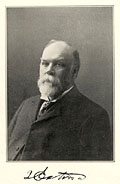 |
|
| |
 Timothy
Eaton, Souvenir Booklet, ca 1905-07. Timothy
Eaton, Souvenir Booklet, ca 1905-07.
|
|
| |
|
|
|
|
| |
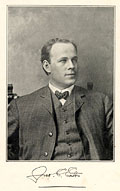 |
|
| |
 John
C. Eaton, Souvenir Booklet, ca 1905-07. John
C. Eaton, Souvenir Booklet, ca 1905-07.
|
|
| |
|
|
|
|
|
|
The first Winnipeg catalogue was published with little fanfare. The
cover
showed a woman fashionably dressed in a fur coat, drawing back the curtain
to
reveal the new Winnipeg store. In 1907, mail-order stock was separated
from retail
and the department moved to the top three floors of the Winnipeg store. In
1909,
the department was organized into separate departments and began to
purchase
its own stock. In 1916, a new building behind the store provided five
acres {16
hectares] of space for the mail-order department. A second huge building
was
built in 1921. Eaton's established distribution centres in Saskatoon
in
1915 and Regina in 1917. Other large Eaton's stores opened in the
West:
Regina in 1926, Saskatoon in 1928, and Calgary and Edmonton in 1929. New
branch
stores carried a more limited range of goods in smaller centres.
|
| |
 |
|
| |
 Eaton's
Winnipeg store, from a set of stereoscopic images, ca 1910. Eaton's
Winnipeg store, from a set of stereoscopic images, ca 1910.
|
|
| |
|
|
|
|
| |
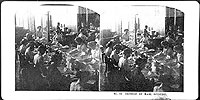 |
|
| |
 Eaton's
Winnipeg mail-order operation, from a set of stereoscopic images, ca
1910. Eaton's
Winnipeg mail-order operation, from a set of stereoscopic images, ca
1910.
|
|
| |
|
|
|
|
There was a strong relationship between Eaton's stores and the
catalogues:
The stores had a "Farmers' Waiting Room" for the use of
rural
shoppers visiting from out of town and invited visitors to the city to see
the
full range of goods and services that supported the catalogue. The
catalogue
also provided a "Personal Shopper" who would scour the
Winnipeg store
for items not found on the catalogue pages.
|
|
Marketing to Practical, Individualistic Men in the
West
| |
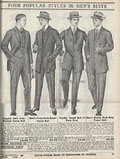 |
|
| |
 Eaton's
(Winnipeg) Spring/Summer Catalogue, 1916, p. 97. Eaton's
(Winnipeg) Spring/Summer Catalogue, 1916, p. 97.
|
|
| |
|
|
|
A comparison of the Toronto and Winnipeg catalogues reveals that
Eaton's
adapted itself to the needs of people living in Western Canada. The
catalogues
were different in format, structure, contents, pricing, and marketing.
Unlike
the Toronto catalogue, which catered to working women in cities as well as
to
rural women, the Winnipeg catalogue catered more to rural men and their
wives.
There were far more single men in the West than women. This emphasis is
apparent
from a glance at the layout of the catalogue. Initially, Winnipeg placed
menswear
at the front; even after conforming to the industry norm of opening with
ladies'
wear, menswear continued to have more prominence on its pages.
| |
 |
|
Slicker coat from Eaton's
(Winnipeg) Fall/Winter Catalogue, 1919-20, (detail).
|
 |
|
Eaton's stated that it understood the preferences of western men.
For
example, a suit with an unusual dip in the front was remarked upon as
being very
popular in the West but did not appear in the Toronto catalogue. Phrases
such
as "Real Men," "The Broncho Shirt," and "The
Harvester"
were featured in early catalogues. Later catalogues endeavoured to appeal
to
the western masculine psyche: Phrases such as "More and more Western
Men
are demanding style and distinctiveness in clothes," "Offering
to
every Western man," and "A Western Canada Favorite" are
common.
Eaton's assured patrons that "Your needs — your
preferences
— your clothing habits — as we know them from our years of
supplying
men of the West — are our guides in planning this catalogue."
Customers
were advised of the practicality of Eaton's menswear. Phrases such
as "Practical
Garments for Practical Men" and "The 'Common
Sense' Idea
Behind All EATON Men's Clothing" were written to appeal to
western
buyers.
|
Clothing for Cold Weather
| |
 |
|
Burberry coat from Eaton's
(Winnipeg) Fall/Winter Catalogue, 1926-27, (detail).
|
 |
|
The Winnipeg catalogues featured more, and more practical, cold-weather
clothing.
In 1905, the first items in the catalogue were men's overcoats,
indicative
of the focus on men's clothing for cold weather that was to prevail.
The
1907 catalogue described the rigorous winters of the West and advertised
coats
adapted to withstand severe, cold, and stormy winters. In 1919-20,
Winnipeg
offered more fur coats, sheepskin coats, overcoats, sweater coats,
mackinaws,
and norfolks, and fewer cloth coats, stoles, and muffs. Toronto sold
raincoats,
whereas Winnipeg sold slickers and oilskins. Interestingly, at a time when
most
coats sold for $20 to $30, Winnipeg carried a Burberrys ulster coat for
$82.00!
This coat was not available through the Toronto catalogue.
The Winnipeg catalogues recognized that westerners spent more time out
of
doors. Eaton's told its shoppers: "Outdoor men will appreciate
'Buckskein'
for comfort just as the Byrd Expedition did when they used it as official
equipment
on their last survey of the frozen reaches of the Antarctic," and
"Materials
are chosen with an eye to Western weather and Western conditions -
cut
and sized with consideration for the activities of Western life -
styled
directly to the Western fancy."
|
Overalls as Practical, Patriotic Workwear
| |
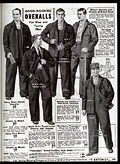 |
|
| |
 Overalls
worn with a shirt and tie in Ontario, Eaton's (Toronto) Fall/Winter
1926-26,
p. 245. Overalls
worn with a shirt and tie in Ontario, Eaton's (Toronto) Fall/Winter
1926-26,
p. 245.
|
|
| |
|
|
|
| |
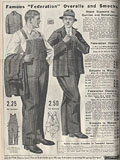 |
|
| |
 Overalls
worn with a work shirt, Eaton's, Winnipeg, Fall/Winter Catalogue, 1919-20. Overalls
worn with a work shirt, Eaton's, Winnipeg, Fall/Winter Catalogue, 1919-20.
|
|
| |
|
|
|
Overalls were featured in the Winnipeg catalogues and their virtues
described
in great detail. Compared to an entire section dedicated to workwear in
Winnipeg,
Toronto carried only one page of overalls. In the Toronto catalogue,
overalls
were worn with a white shirt and, in some cases, a tie, whereas in
Winnipeg they
were worn with work shirts. Both catalogues featured
"Federation"
overalls, but the Winnipeg catalogue provided details of construction
features,
such as double seats and knees, strong elastic, and denim suspenders. Some
of
the Toronto models held props, while the Winnipeg models all held hoes and
were
shown working. Winnipeg's 1935-36 catalogue included a tribute
to
overalls: "The rugged pioneers of farm and trail, of mine and
forest, placed
faith in the overall's utility. Today, as in years gone by, the men
of
farm, forest, mine and railroad, wear the overall."
|
|
| |
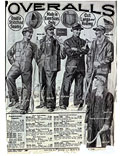 |
|
Advertisement for Federation
overalls, Eaton's (Winnipeg) Spring/Summer Catalogue, 1924,
p. 152-153.
|
 |
|
|
| |
| |
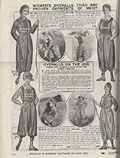 |
|
| |
 Eaton's
(Winnipeg) Spring/Summer Catalogue, 1918, p. 188. Eaton's
(Winnipeg) Spring/Summer Catalogue, 1918, p. 188.
|
|
| |
|
|
|
During the First World War, western women were encouraged to do their
patriotic
duty to contribute to the war effort by wearing overalls, as the women in
Great
Britain and France did. A western woman was quoted: "They are a
sensible
garment, and I wouldn't want to wear skirts again around the
farm."
The Toronto catalogue also carried a selection of women's overalls
but
they were not highlighted in the same way. Winnipeg continued to show
women in
overalls in the 1920s, whereas Toronto did not.
|
Comfort over Fashion in Women's Clothing
Until the 1930s, the Winnipeg catalogues promoted utility, value, and
comfort
over style in women's clothing. Toronto featured complete ensembles
to
show how pieces could fit together and showed more garments for specific
purposes.
In 1918, the Toronto catalogue claimed to be the "Canadian
Woman's
Own True Fashion Book," a claim not made by Winnipeg. In the 1920s,
the
Toronto catalogue was written like a fashion magazine, with an attempt at
sophistication.
Riding habits were available through Winnipeg before they were introduced
in
Toronto. When Toronto introduced breeches, there were fewer styles to
choose
from and they were recommended as sportswear.
Toronto showed housedresses "For the Housewife and Her
Helper"
and aprons for maids, whereas Winnipeg promoted wash dresses for
housewives and
nurses. Winnipeg showed more housedresses than did Toronto — the
ratio
was 14 to 8 in 1923-24 fall-and-winter catalogues. Toronto and
Winnipeg
described the same housedress differently. Toronto noted, "If you
are wearing
this pretty Checked Gingham Dress even unexpected visitors will not
disconcert
you for they will find you neatly and becomingly garbed." Winnipeg
asserted:
"Made in a style that looks well, and one that you will not tire
of."
There was no suggestion that a woman on the Prairies would be disconcerted
if
an unexpected visitor found her in a housedress.
|
Larger Sizes in the West
|
Winnipeg consistently showed garments on larger, full-figured women.
The same
styles often looked different because of the models used. For example, an
apron
shown in Toronto on a slim, fashionable model, was shown on an overweight,
matronly-looking
woman in Winnipeg. At the same time, Toronto tended to be more diplomatic,
using
the phrases "larger sizes" or "extra size,"
whereas Winnipeg
referred to "stout women." In 1919, Winnipeg carried ten
dresses
recommended for stout figures, compared to only three in Toronto.
|
| |
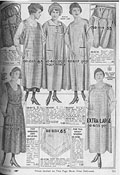 |
|
| |
 Eaton's
Winnipeg Fall/Winter Catalogue, 1919-20, p. 315. Eaton's
Winnipeg Fall/Winter Catalogue, 1919-20, p. 315.
|
|
| |
|
|
|
|
| |
 |
|
| |
 Eaton's
(Toronto) Fall/Winter Catalogue, 1919-20, p. 166. Eaton's
(Toronto) Fall/Winter Catalogue, 1919-20, p. 166.
|
|
| |
|
|
|
|
One aspect of the catalogue that was markedly different was that of
ladies'
undergarments. The Toronto spring-and-summer catalogue of 1915 began with
stylish
models, then showed the more serviceable ones, whereas the Winnipeg
catalogue
showed serviceable models first.
| |
 |
|
| |
 Eaton's
Toronto Spring/Summer Catalogue, 1915, p. 113. Eaton's
Toronto Spring/Summer Catalogue, 1915, p. 113.
|
|
| |
|
|
|
Toronto said the Nemo "self-reducing corset" is
"specially
adapted for short, stout women who require a general figure reduction and
a moderate
degree of abdominal support." Winnipeg illustrated the Nemo against
a backdrop
of a woman working in the fields and described it as "a particularly
good
corset for the housekeeper, as it is so strong, serviceable and
comfortable"
and an "Excellent model for women who are hard on their
corsets."
| |
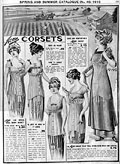 |
|
Eaton's (Winnipeg)
Spring/Summer
Catalogue, Winnipeg, 1915, p. 113.
|
 |
|
Toronto introduced pretty lingerie, brassieres, and bandeaus in 1919,
before
Winnipeg. Winnipeg continued to place more emphasis on corsets than
brassieres
and bandeaus throughout the 1920s and featured more short and extra-size
garments
as well as illustrations of larger women.
|
|
Page 2 >>
|
|